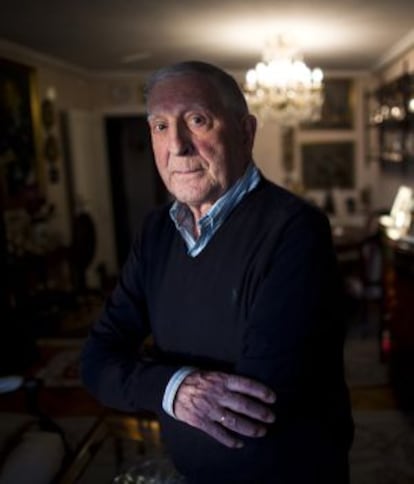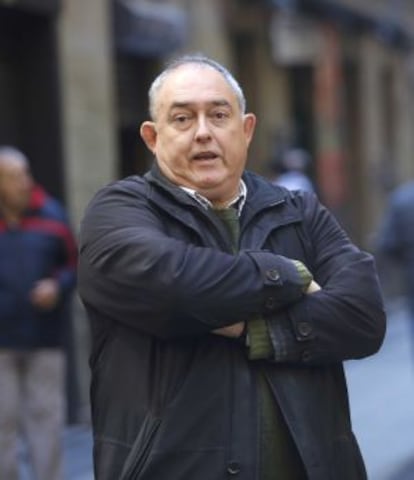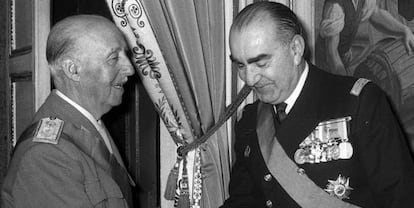The day ETA struck a lethal blow to the Franco regime
Forty years ago this week, the dictator's heir apparent, Carrero Blanco, was assassinated The terrorist organization was responsible for the bombing, which left a huge crater in its wake

The morning of December 20, 1973 was freezing cold in Madrid. At 9.35am, a black Dodge Dart drove down Claudio Coello street, in the upscale Salamanca neighborhood, and rolled past a building owned by the Jesuits. The occupants of the car were Prime Minister Luis Carrero Blanco - Franco's heir apparent - his chauffeur and a police inspector. When the Dodge reached number 104 of that street, a double-parked Austin forced it to swerve to the right. At that precise moment, 9.36am, ETA member Jesús Zugarramurdi (better known as "Kiskur") made a sign to José Miguel Beñarán (alias "Argala"), who was up on a ladder, disguised in electrician overalls. Argala pressed the button.
Instantly the ground opened up under the Dodge, and the car with its three occupants inside was blasted 35 meters straight up into the air. The car sailed over the building and teetered on the eaves of the roof before crashing down into the inner courtyard. There was a deafening noise, rubble rained down on the street, and a cloud of dust rose up in the air.
The car sailed over the building and crashed down into an inner courtyard
In the middle of all the confusion, Kiskur and Argala yelled out "Gas! Gas!" and started running toward the nearby street of Diego de León. Waiting for them inside a vehicle, on the corner of Lagasca, was the third member of the ETA cell in charge of the assassination, Javier Larreategi, or "Atxulo." The car headed for the Rubén Darío junction and took Miguel Ángel street, where the killers stopped in front of the police academy and switched vehicles before heading for their hideout on Hogar street, in the nearby town of Alcorcón.
Meanwhile, confusion reigned on and around Claudio Coello street. Carrero Blanco died at 10.15am in hospital. His two companions in the car, who also survived the initial blast and crash, died of their wounds soon after. The dictatorship's news services did not report that ETA was behind the attack until 5pm. At 11pm that same night, the Basque group took credit for the assassination in a release aired on Radio Paris. An hour later, Deputy Prime Minister Torcuato Fernández-Miranda confirmed the news.
All three ETA members stayed holed up in their Alcorcón apartment until the end of the month, when they were spirited away by their Madrid contact, Eva Forest, a Spanish Communist Party (PCE) dissident. A truck drove them north to Hondarribia, a Basque border town in Gipuzkoa. From there, they crossed into France over the Bidasoa river.

The assassination of Carrero Blanco shook Francoist Spain, which had grown unaccustomed to violence after the Spanish Communists had given up on guerrilla warfare and opted for national reconciliation in the 1950s. This was the second organized killing by ETA - the first one dated back to 1968, when it assassinated the police chief of San Sebastián, Melitón Manzanas - and the one that brought international attention to the terrorist organization.
The story behind this assassination of a national leader goes back to 1972. Ángel Amigo - then an ETA activist who was arrested in 1973, became a film producer in 1980, and who has earned several industry awards since - says that Argala, then 23, had become a trusted aide to the ETA leadership. During the course of 1972 he traveled several times to Madrid with a triple goal: establishing contacts with the Spanish left, setting up infrastructure in the capital, and checking out the possibilities of an attack in order to relieve the pressure on his organization back in the Basque region.
News services held off from reporting that ETA was behind the attack
Argala found the person he was looking for: Eva Forest, who was married to the playwright Alfonso Sastre, both PCE dissidents. The couple felt sympathy for the world's liberation movements - in Vietnam, Latin America, Palestine and elsewhere. Argala convinced them that ETA was part of the global anti-imperialist struggle.
Forest offered Argala a very valuable piece of information: Carrero Blanco, Franco's successor and then deputy prime minister, went to Mass every day at the same time in the same place, in the company of just one bodyguard. When Argala checked this out for himself, he was puzzled.

Amigo also notes that in 1977 Forest - who died six years ago - told him about how she wrote a story about the attack, Operación Ogro, which she peppered with false clues in order to protect the perpetrators, who were living undercover. Forest wrote it with help from the killers themselves, just three months after the attack, inside a villa in Ciboure, a village in the French Basque Country where many ETA members used to hide out in the 1970s and 1980s.
Published under the pseudonym of Julen Aguirre, the story claimed that the group fled to Portugal immediately after the assassination, when in fact all three members had remained in Madrid for several days.
Forest also created a fictitious character to protect herself, and claimed that this individual met with Argala at a cafeteria called Mindanao, on San Francisco de Sales street in Madrid, to tell him about Carrero Blanco's surprisingly predictable daily routines. It was this fictional character who spawned the widespread myth that the CIA was behind the assassination. No declassified CIA document ever made the slightest reference to the attack, Amigo insists. Still, there is a wealth of literature pointing to the CIA as the intellectual instigator of the crime.
The perpetrators
Forty years on, two of the three members of the unit that assassinated Carrero Blanco are dead, as is their main liaison in Madrid.
- José Miguel Beñarán, or Argala, was 24 at the time of the assassination, and died five years later in an attack perpetrated by the paramilitary group Batallón Vasco Español (Spanish Basque Battalion) on French territory. The way he was killed was very similar to the way he himself had murdered Carrero Blanco: an explosive charge went off when he turned on the ignition of his car. By then he had become the ideologue of ETA's military branch and a supporter of terrorism who opposed the process of democratic reform.
- Javier Larreategi, Atxulo, was 22 at the time of the attack, and died of cancer in 2008. For years he was the chief of ETA's international wing, working out of Nicaragua under the Sandinista regime. In 1994, under the Violeta Chamorro administration, he was extradited to Spain. Months later the High Court released him and he went back to the Basque Country, where he lived until the end of his days. The bombing of Carrero Blanco was subject to the 1977 Amnesty Law.
- Jesús Zugarramurdi, Kiskur, was 25 at the time of the killing and is the only surviving member of the cell. In 1984 he survived an attack by GAL, a secret government anti-terrorist unit that was operational in the 1980s.
- Eva Forest was 45 at the time of the attack. Born in Barcelona in 1928, this essential figure in the assassination plans was the only non-Basque in the group. She was also the only member to be arrested by the Franco regime, nine months after the bomb plot, and charged with the crime. She was released from prison in 1977 following the amnesty and resided in Hondarribia until her death from disease in 2007.
- The ETA chiefs: Txomin Iturbe was 30 years old in 1973 and died in an accident in 1987. Ezkerra was arrested in 1975 and released in 1977 following the amnesty. He now lives in the Basque Country. The location of Josu Ternera is not known. He remained with ETA and defended its definitive end in 2011.
General Ángel Ugarte, who was head of the secret services in the Basque Country (the genesis for the subsequent national intelligence service Cesid) between 1972 and 1979, is adamant: "The attack against Carrero Blanco was carried out by ETA with logistical support from the Spanish Communists," he says in reference to Eva Forest and her network of leftist relations in Madrid. "The ETA members were unable to move around in Madrid with ease, and Forest, who had very good connections in the capital, was their self-appointed guide."
Another argument against the CIA theory is ETA's attitude, adds Amigo: "When Argala told his ETA bosses - Txikia, Txomin and Ezkerra - what he'd learned about Carrero Blanco, at first they considered not killing him but kidnapping him in exchange for the release of the 150 ETA members behind bars at that time."
In late 1972, Argala, Ignacio Pérez Beotegi, alias "Wilson," and Javier Larreategi, known as "Atxulo," settled down in Madrid to prepare the kidnapping. They figured that getting their man and neutralizing his bodyguard inside the church would require three four-member cells. They rented new houses and a clothing store near the Santiago Bernabéu soccer stadium where they planned to keep their hostage.
All this planning took them until April, when ETA suffered two setbacks. First, the clothing store was broken into by thieves, forcing the plotters to abandon it. Then one of their leaders, Txikia, was killed in a shootout with the police in the Basque town of Algorta.
After that, in May, ETA had the nerve to organize a meeting in Getafe, outside Madrid, to analyze the consequences of that death. For a few months, there was a constant coming and going of ETA leaders and members to Madrid and back - nearly 30 of them in all. As a replacement for the clothing store, they built a zulo (a small secret space to conceal weapons or kidnapped persons) inside an apartment on Hogar street in Alcorcón, offered to them by Eva Forest. With assistance from Antonio Durán, a construction worker and former PCE member, up to 10 ETA members worked on the zulo that was to hold Carrero, with Argala acting as "site manager."
Ugarte, who was then head of the secret services in the Basque Country, believes that such a brazen approach "would be unthinkable today. Back then the police and the Civil Guard knew very little about ETA. Information was really basic, and there was no coordination. The danger posed by the group was underestimated. It's false that the attack was allowed to take place by high-placed people. Nobody realized what they were up to and I can safely say that it caught us off guard - us and the regime, which at that point was mainly concerned with the fact that Franco was dying."
Ángel Amigo confirms, out of personal experience, that the police at the time tended to use repression rather than information. He also agrees with Ugarte in that Txikia could have easily been arrested rather than killed.
On June 9, ETA found to its surprise that Franco was appointing Carrero Blanco as the nation's new prime minister. The plotters decided to postpone any further action until September, when the Madrid cell returned to the capital and labeled itself Comando Txikia as a tribute to their fallen leader. Wilson stayed behind in France because of internal discrepancies and was replaced by Kiskur, who traveled to Madrid with Argala, Atxulo and a new boss: Josu Urrutikoetxea, better known as "Josu Ternera."
Nobody realized what they were up to; I can safely say it caught us off guard"
This cell confirmed that Carrero's new position meant more bodyguard security. ETA now favored killing him rather than kidnapping him, but was unclear on how to do it. Ezkerra went to Madrid to tell the group that it would no longer be necessary to have so many people working on this project. All the apartments save for the ones in Aluche and Alcorcón were dropped. In order to familiarize themselves with Madrid and stay on their toes, on September 25 the ETA members broke into a gunsmith's and on October 2 they stole a rifle from a soldier standing guard at Madrid military headquarters on Calle Mayor.
It was Argala who figured out how to carry out the attack. In early November, he realized that there was a ground-level space for rent on number 104, Claudio Coello - the street that Carrero Blanco drove down every day. It immediately came to him: they would dig a tunnel from this spot all the way to the center of the street, place explosives there and set them off when Carrero's car went by. ETA chiefs approved the plan.

Atxulo passed himself off as a sculptor to justify the noise they would make building the tunnel. In late November, Txomin and Ezkerra traveled to Madrid and told the unit to carry out the assassination before year's end. The tunnel got dug, albeit with great difficulty, between December 7 and 15. It helped that in 1970 Argala had dug another tunnel near a Burgos penitentiary in an attempt to free ETA inmates being held there. Ezkerra and Txomin brought the explosives. They set the attack for December 19, but postponed it to the following day when they heard that US Secretary of State Henry Kissinger was coming to Madrid - the US Embassy was very near the planned site of the attack.
On December 17 and 18, the three remaining ETA members in Madrid packed their bags and went through the motions one last time. On the morning of December 20, at 8am, they went down the tunnel to lay out the 75 kilograms of explosives in a T shape. By 9am all three were stationed at their posts on Claudio Coello street, waiting for Carrero Blanco's car to show up. At 9.35 the Dodge came into sight. One minute later, it was flying in the air.
The regime was mainly concerned with the fact that Franco was dying"
Ángel Ugarte admits that ETA achieved three goals: revenge for its nine dead members up to that time; a showy attack that attracted international attention; and an attempt to break the regime's back. But Ugarte adds nuance to this latter statement: "With Carrero it is possible that the regime would have evolved, albeit more slowly, toward democracy. But a regime change was inevitable. We could see that. The prince was the unofficial king, and Carrero would never have acted against his wishes. He was very disciplined. He would have submitted, just like the others."
Ugarte still expresses amazement at "the audacity and the madness" of those young men, aged 24 on average, and harbors no doubt that it was them, with support from Eva Forest and her left-wing network in Madrid, who carried out the assassination.
Amigo thinks that an attack of that nature would be impossible these days for many reasons: "We youngsters came of age in a dictatorship and were raised on stories of the Civil War and repression. We thought it was possible to do here what the guerrillas were doing in Latin America. The impact of the Burgos Trial of 1970, in which ETA convicts came out the moral victors, was stimulating to us. Youth and boldness made possible what today would be impossible. That reference is gone. The guerrilla fight is over. Most of the Burgos convicts returned to the fold of society after the amnesty and now they defend their ideas through democratic channels. And above all, Franco and the dictatorship no longer exist."
Tu suscripción se está usando en otro dispositivo
¿Quieres añadir otro usuario a tu suscripción?
Si continúas leyendo en este dispositivo, no se podrá leer en el otro.
FlechaTu suscripción se está usando en otro dispositivo y solo puedes acceder a EL PAÍS desde un dispositivo a la vez.
Si quieres compartir tu cuenta, cambia tu suscripción a la modalidad Premium, así podrás añadir otro usuario. Cada uno accederá con su propia cuenta de email, lo que os permitirá personalizar vuestra experiencia en EL PAÍS.
¿Tienes una suscripción de empresa? Accede aquí para contratar más cuentas.
En el caso de no saber quién está usando tu cuenta, te recomendamos cambiar tu contraseña aquí.
Si decides continuar compartiendo tu cuenta, este mensaje se mostrará en tu dispositivo y en el de la otra persona que está usando tu cuenta de forma indefinida, afectando a tu experiencia de lectura. Puedes consultar aquí los términos y condiciones de la suscripción digital.
Últimas noticias
Most viewed
- Sinaloa Cartel war is taking its toll on Los Chapitos
- Oona Chaplin: ‘I told James Cameron that I was living in a treehouse and starting a permaculture project with a friend’
- Reinhard Genzel, Nobel laureate in physics: ‘One-minute videos will never give you the truth’
- Why the price of coffee has skyrocketed: from Brazilian plantations to specialty coffee houses
- Silver prices are going crazy: This is what’s fueling the rally









































